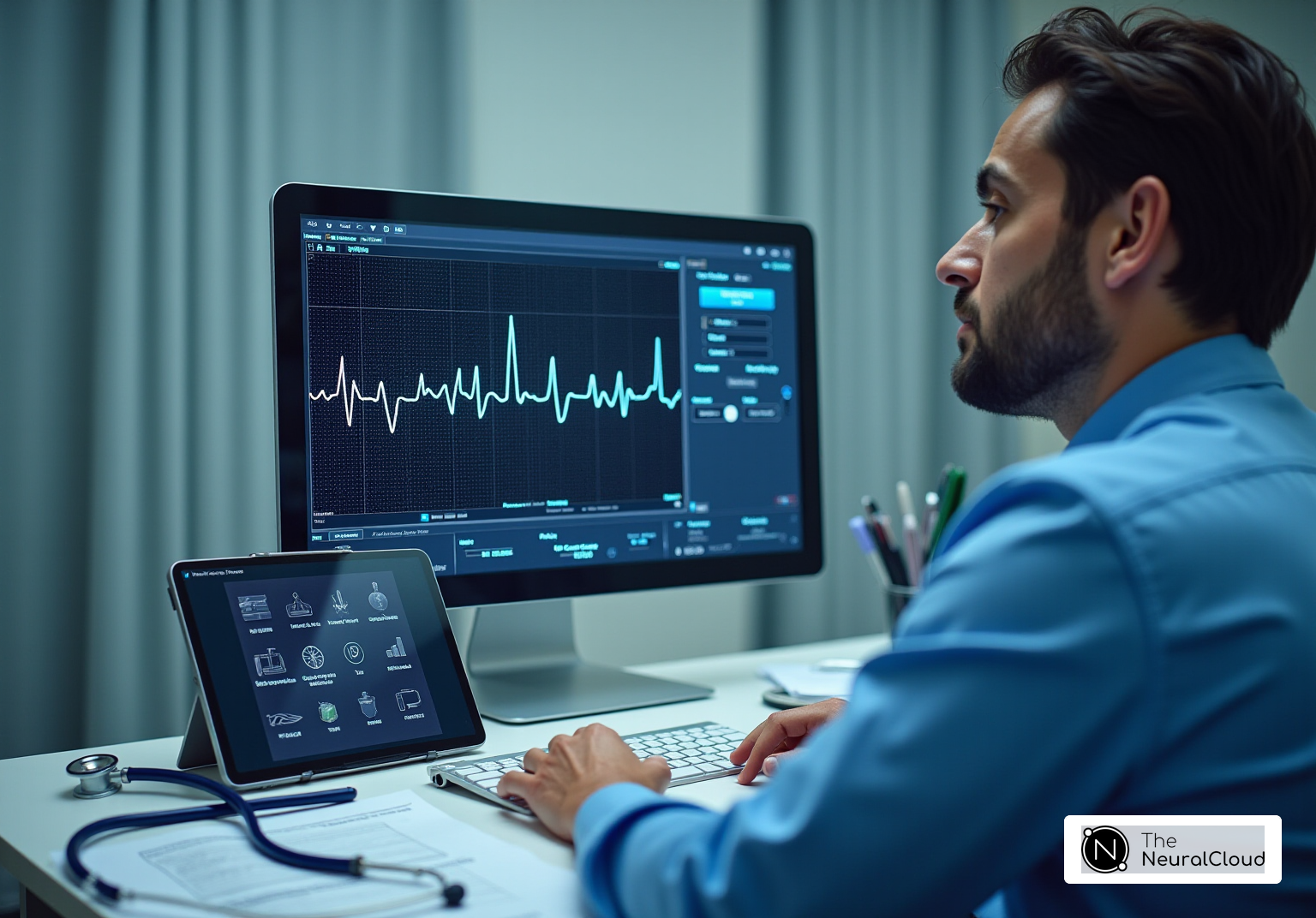Overview
The article provides essential insights for health tech developers on the importance and management of ventricular rhythms in ECG analysis. It begins by addressing the challenges faced in ECG analysis, including noise and physiological variability in ECG signals. The focus then shifts to the features of Neural Cloud Solutions' MaxYield™ platform, which automates ECG analysis. This automation significantly enhances diagnostic accuracy and efficiency. As a result, patient outcomes improve, showcasing the transformative potential of this technology for healthcare professionals.
Introduction
The heart's electrical activity constitutes a complex symphony, where each beat plays a crucial role in sustaining life. Among the most critical elements of this rhythm are the ventricular rhythms, which can lead to life-threatening conditions when disrupted. For health tech developers, grasping these rhythms transcends mere academic interest; it represents a pivotal opportunity to enhance diagnostic tools and improve patient outcomes. However, given the rapid evolution of technology and the increasing complexity of cardiac conditions, developers face the challenge of ensuring their innovations effectively address the identification and management of these vital rhythms.
Neural Cloud Solutions' MaxYield™: Transforming ECG Analysis for Ventricular Rhythms
Neural Cloud Solutions' platform revolutionizes ECG analysis by automating the detection and labeling of various ventricular rhythms. This innovative system utilizes to process over 200,000 heartbeats in under five minutes, providing clinicians with rapid and accurate insights. Such capability is vital for identifying ventricular rhythms, as it enhances the clarity of ECG signals through advanced noise filtering and artifact handling. By isolating and labeling key features in every heartbeat, the system reduces the impact of noise and artifacts, allowing for more reliable diagnoses and treatment plans. Furthermore, its adaptive algorithm evolves with each use, continuously improving accuracy and efficiency. This evolution is essential for overcoming physiological variability in ECG analysis, ultimately benefiting healthcare professionals in their clinical decision-making.
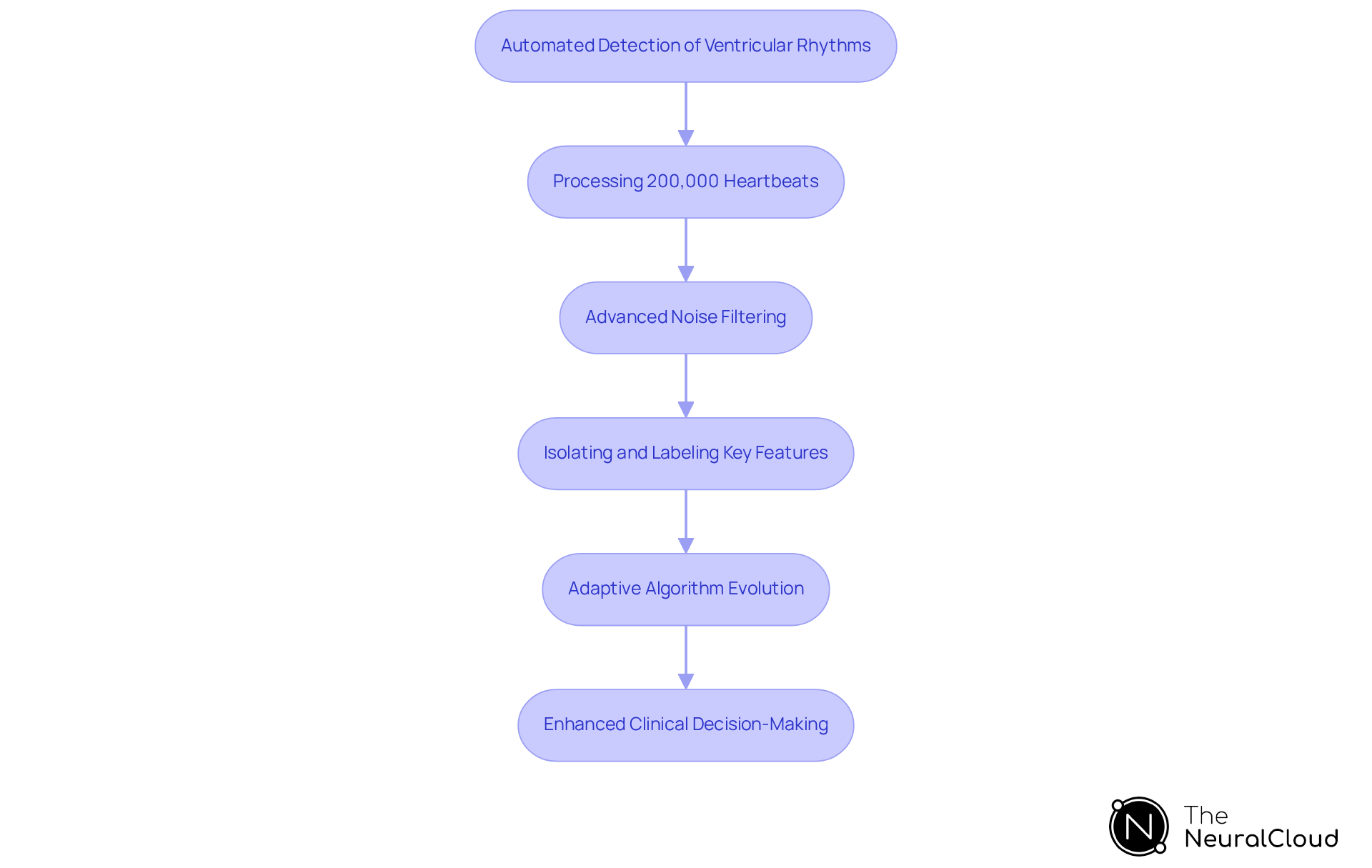
Understanding Ventricular Rhythms: Definition and Clinical Importance
The electrical impulses originating in the heart's ventricles, known as ventricular rhythms, are crucial for effective cardiac function. Abnormalities in ventricular rhythms can lead to serious conditions, including ventricular tachycardia or fibrillation, which may result in sudden cardiac arrest. For health technology creators, understanding ventricular rhythms is essential for developing solutions that accurately monitor and manage these life-threatening conditions.
MaxYield™ offers advanced capabilities that significantly enhance ECG analysis. This platform features and distinct wave recognition, which improve analysis efficiency. It identifies and labels critical data in recordings, even in high noise and artifact conditions. Additionally, MaxYield™ salvages previously obscured sections of lengthy Holter, 1-Lead, and patch monitor recordings, addressing the challenges posed by physiological variability and signal artifacts.
The advantages of using MaxYield™ are substantial for healthcare professionals. By improving the accuracy and efficiency of ECG interpretation over time, the platform effectively aids in monitoring ventricular rhythms. This ultimately enhances patient care and outcomes, making it an essential tool for those in the medical field.
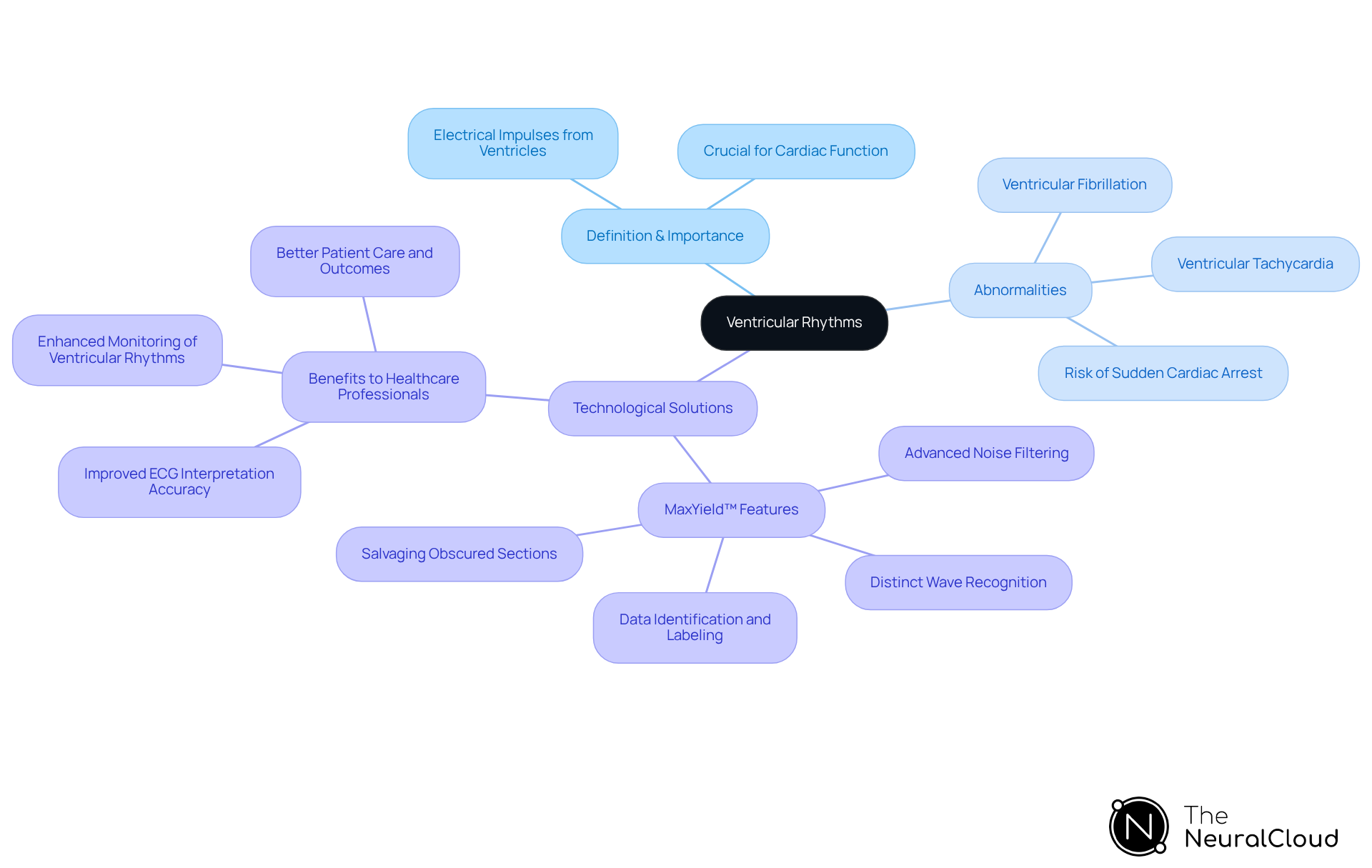
Types of Ventricular Arrhythmias: Key Variants Every Cardiologist Must Identify
Key types of ventricular arrhythmias include:
- Ventricular Tachycardia (VT): This condition is characterized by a rapid heartbeat originating from the ventricles.
- Ventricular rhythms, including Ventricular Fibrillation (VF): A chaotic rhythm that can lead to cardiac arrest.
- Premature Ventricular Contractions (PVCs): These extra heartbeats are a type of ventricular rhythms that disrupt the normal rhythm.
Each type presents unique challenges for diagnosis and management. It is essential for health technology creators to ensure their tools can accurately identify and differentiate these conditions.
Neural Cloud Solutions' MaxYield™ platform addresses these challenges by utilizing advanced noise reduction and artifact handling features. This technology converts noisy ECG recordings into . Key features of the platform include:
- Automated Analysis: The platform processes 200,000 heartbeats in under five minutes.
- Detailed ECG Characteristics: It provides comprehensive information on P-wave, QRS complex, and T-wave analysis, which are crucial for identifying cardiac events.
This level of precision supports confident clinical decision-making. It enhances the ability to manage physiological variability and signal artifacts effectively.
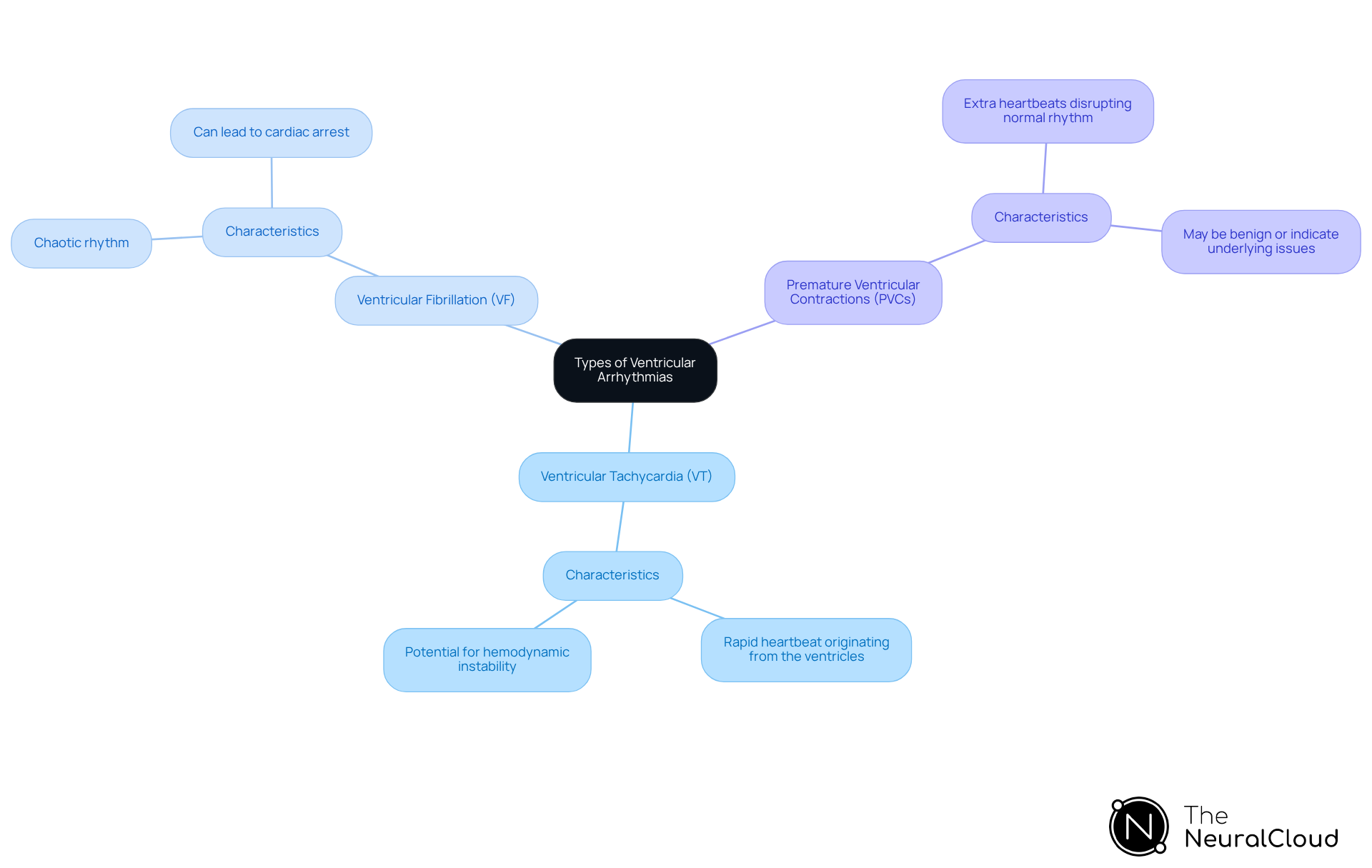
Mechanisms of Ventricular Rhythms: Physiological Insights for Cardiologists
Several physiological factors, such as electrolyte imbalances, ischemia, and structural changes in the heart, shape ventricular rhythms. The heart's electrical conduction system is vital for sustaining normal rhythms. When disruptions occur within this system, irregular heartbeats can result. Understanding these mechanisms allows cardiologists to related to ventricular rhythms more effectively and develop targeted treatment plans. This knowledge is crucial for health technology creators who aim to design efficient diagnostic tools.

Causes of Ventricular Arrhythmias: Identifying Risk Factors and Triggers
Ventricular rhythms can be influenced by various factors, such as:
- coronary artery disease
- heart failure
- congenital heart defects
Additional risk factors include:
- high blood pressure
- diabetes
- a history of heart disease
Recognizing these triggers is essential for formulating preventive strategies and effective management protocols. By leveraging this information, health technology developers can create predictive models that help clinicians identify at-risk patients early.
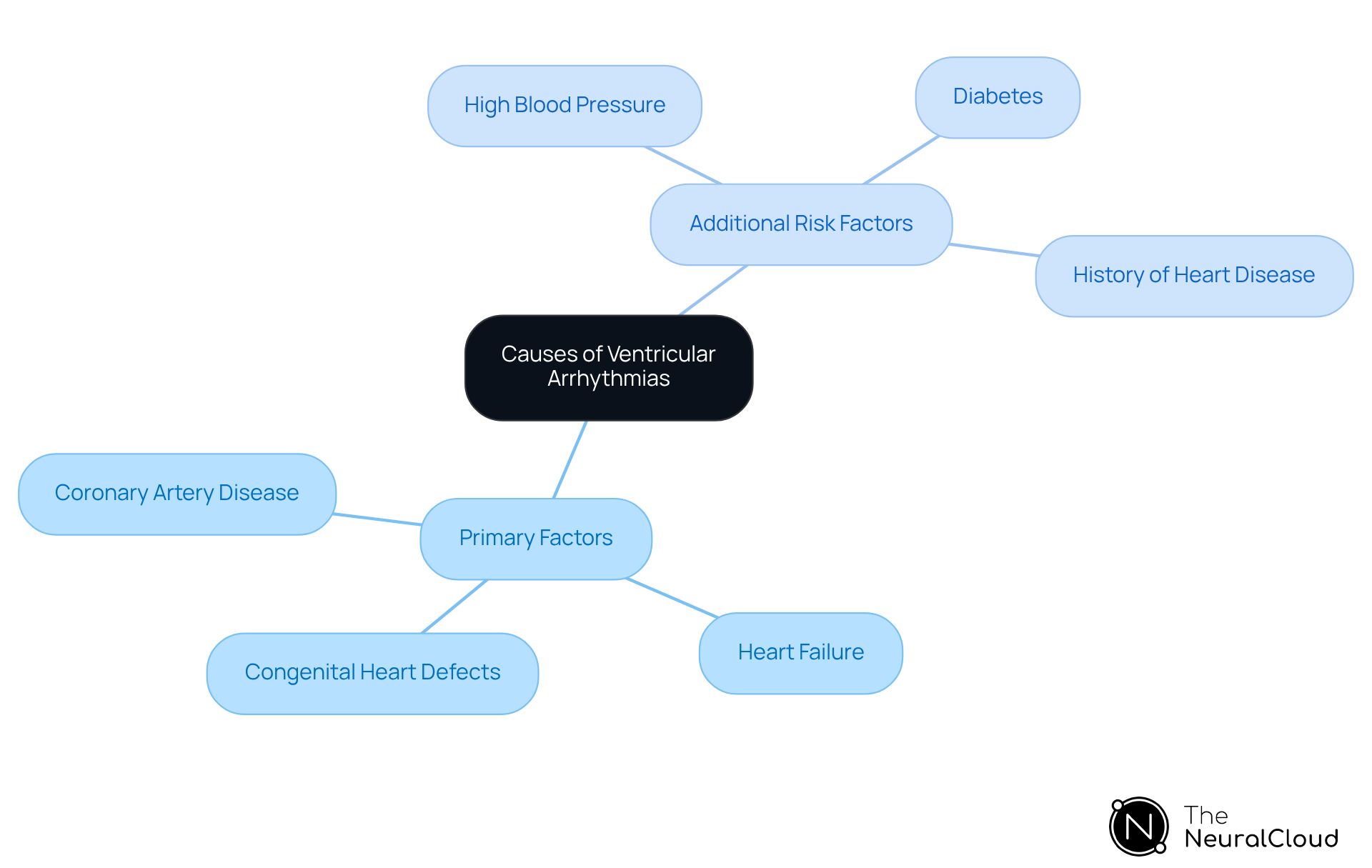
Symptoms of Ventricular Arrhythmias: Recognizing Clinical Presentations
Symptoms of ventricular rhythms can vary widely, including:
- Palpitations
- Dizziness
- Syncope
- Chest pain
In severe cases, patients may experience:
- Shortness of breath
- Loss of consciousness
Recognizing these symptoms related to ventricular rhythms is critical for healthcare providers to initiate timely interventions. Health technology creators must ensure their ECG analysis instruments, particularly those utilizing the specified platform, can automate the identification of these symptoms through automated ECG labeling and data extraction for further assessment. By integrating wearable technology with MaxYield™, developers can significantly enhance the efficiency of ECG analysis. This integration not only reduces operational costs through streamlined processes but also improves the accuracy of symptom recognition. Ultimately, these advancements lead to .
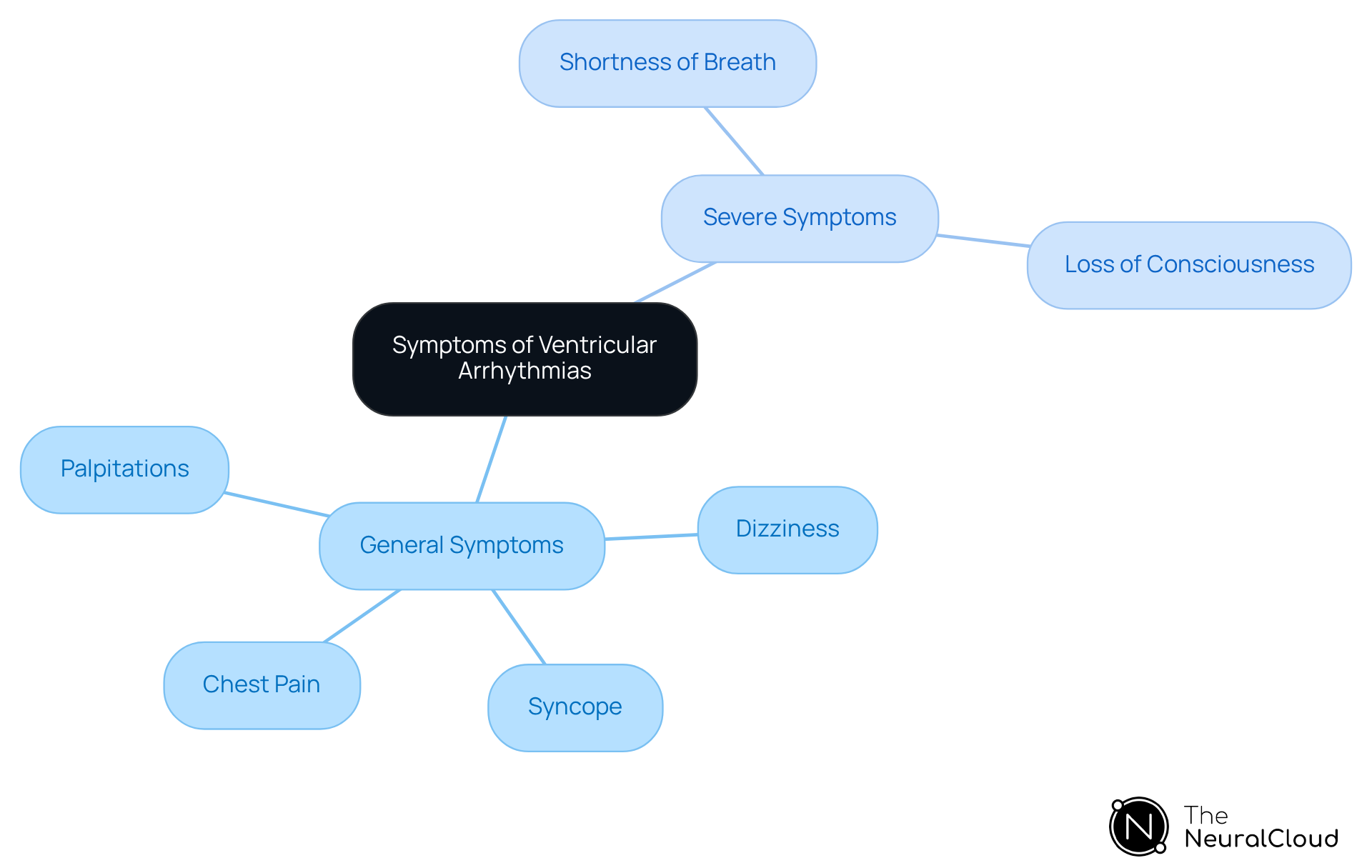
Diagnostic Approaches for Ventricular Arrhythmias: Tools and Techniques
Diagnostic methods for assessing ventricular rhythms include:
- 12-lead ECGs
- Holter monitoring
- Event recorders
These tools facilitate continuous observation and can identify transient irregular heartbeats that may elude detection during a standard ECG. The MaxYield™ platform enhances these diagnostic tools by integrating advanced noise filtering and automated ECG signal labeling. This innovation addresses challenges such as , leading to clearer and more accurate detection of irregular heartbeats. For more complex cases, electrophysiological studies may also be utilized, with MaxYield™ further enhancing efficiency and clarity. By focusing on these cutting-edge solutions, developers can significantly improve the accuracy of irregular heartbeat detection in their platforms.
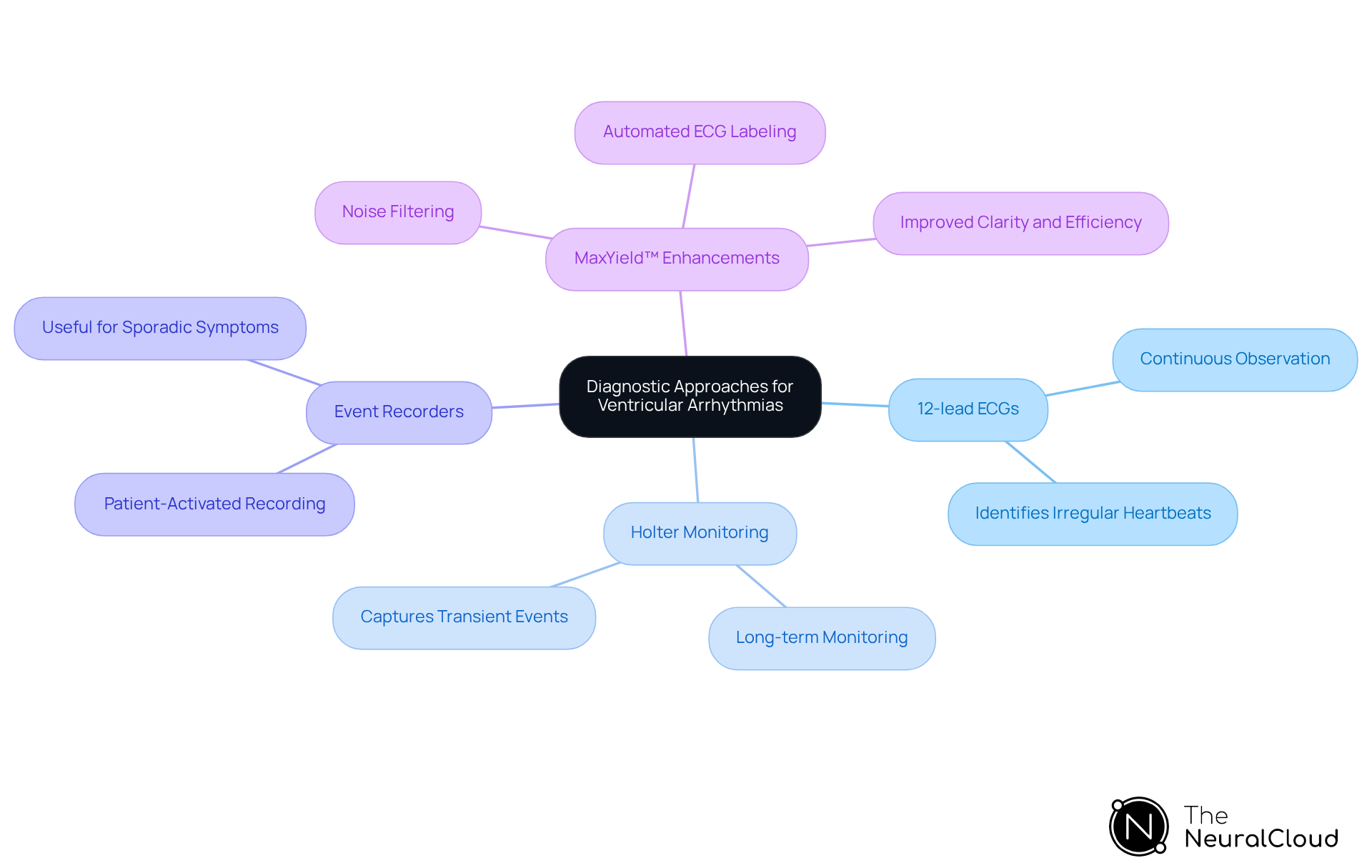
Management Strategies for Ventricular Arrhythmias: Treatment Options and Protocols
Management strategies for addressing ventricular rhythms may include lifestyle modifications, medication, and invasive procedures such as catheter ablation or implantable cardioverter-defibrillators (ICDs). The choice of treatment depends on the type and severity of the arrhythmia, as well as the patient's overall health. Health technology creators should consider integrating treatment guidelines into their platforms to aid clinicians in making informed decisions.
The MaxYield™ platform addresses the challenges in ECG analysis by providing advanced features that enhance diagnostic accuracy. It utilizes an automated noise reduction system and an adaptive algorithm, which significantly improve the clarity of ECG signals. One of its key features is the rapid labeling of P, QRS, and T Wave onsets and offsets, which allows for beat-by-beat tabulation in CSV format. This feature facilitates easy integration into existing systems, streamlining clinical workflows.
The advantages of the MaxYield™ platform extend beyond clarity; it also salvages previously obscured sections of recordings and supports the . These capabilities ultimately aid healthcare professionals in making better clinical decisions. By utilizing this innovative platform, clinicians can enhance their diagnostic processes, leading to improved patient outcomes.
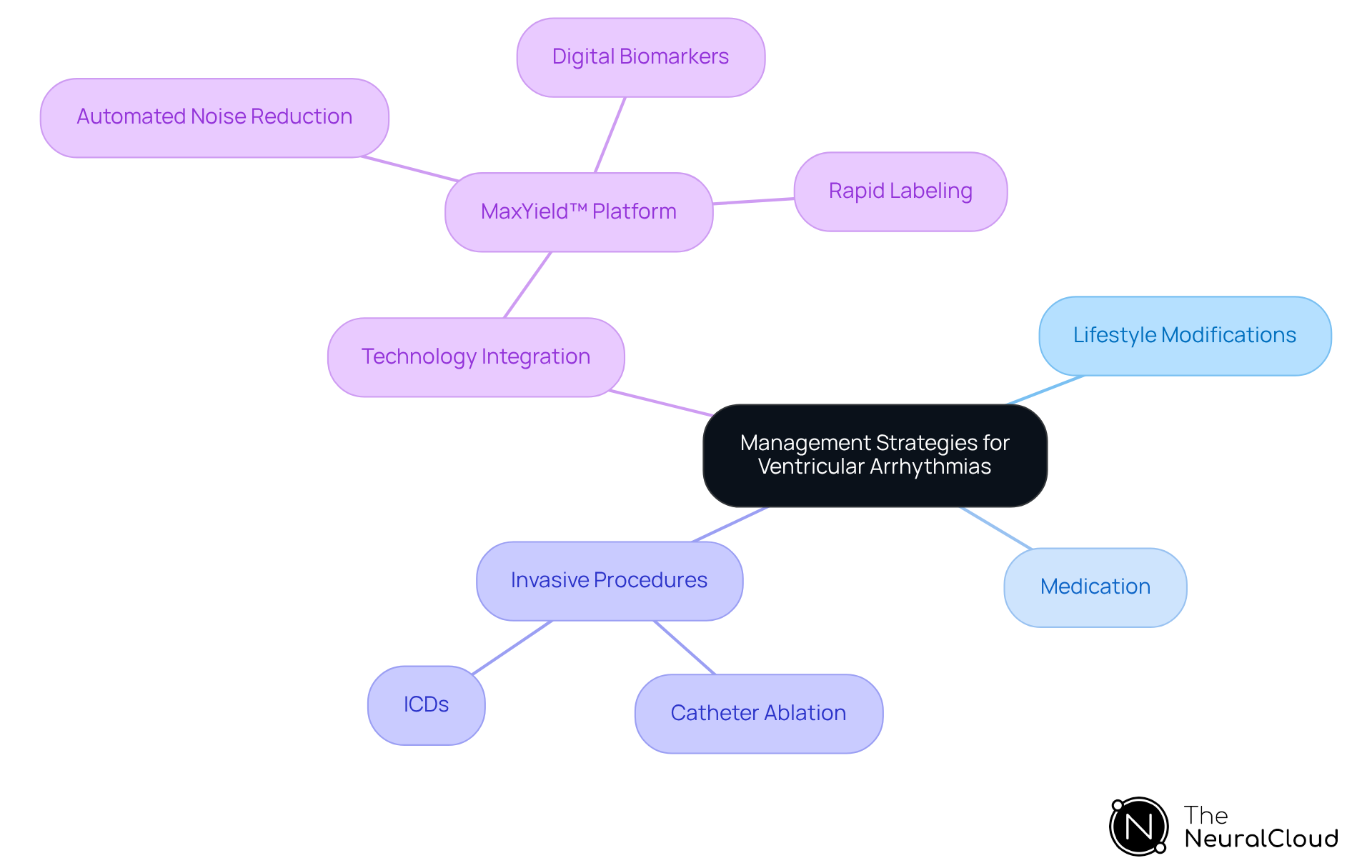
Prognosis of Ventricular Arrhythmias: Understanding Patient Outcomes
The prognosis of ventricular rhythms varies significantly based on the underlying cause, the type of disturbance, and the overall health of the patient. Early detection and appropriate management can lead to improved outcomes, while untreated arrhythmias may result in severe complications, including sudden cardiac death. Health technology creators should concentrate on designing tools that not only diagnose but also monitor patient outcomes over time to improve care quality. By leveraging advanced technologies like Neural Cloud Solutions, developers can significantly enhance ECG analysis efficiency.
This system specifically addresses challenges such as physiological variability and signal artifacts through its and wave recognition capabilities, transforming noisy recordings into clear waveforms. Incorporating wearable technology with this system enables automated labeling, lowering expenses and ultimately enhancing patient care results. The combination of these features ensures that healthcare professionals can rely on accurate data for better decision-making, thus improving overall patient outcomes.
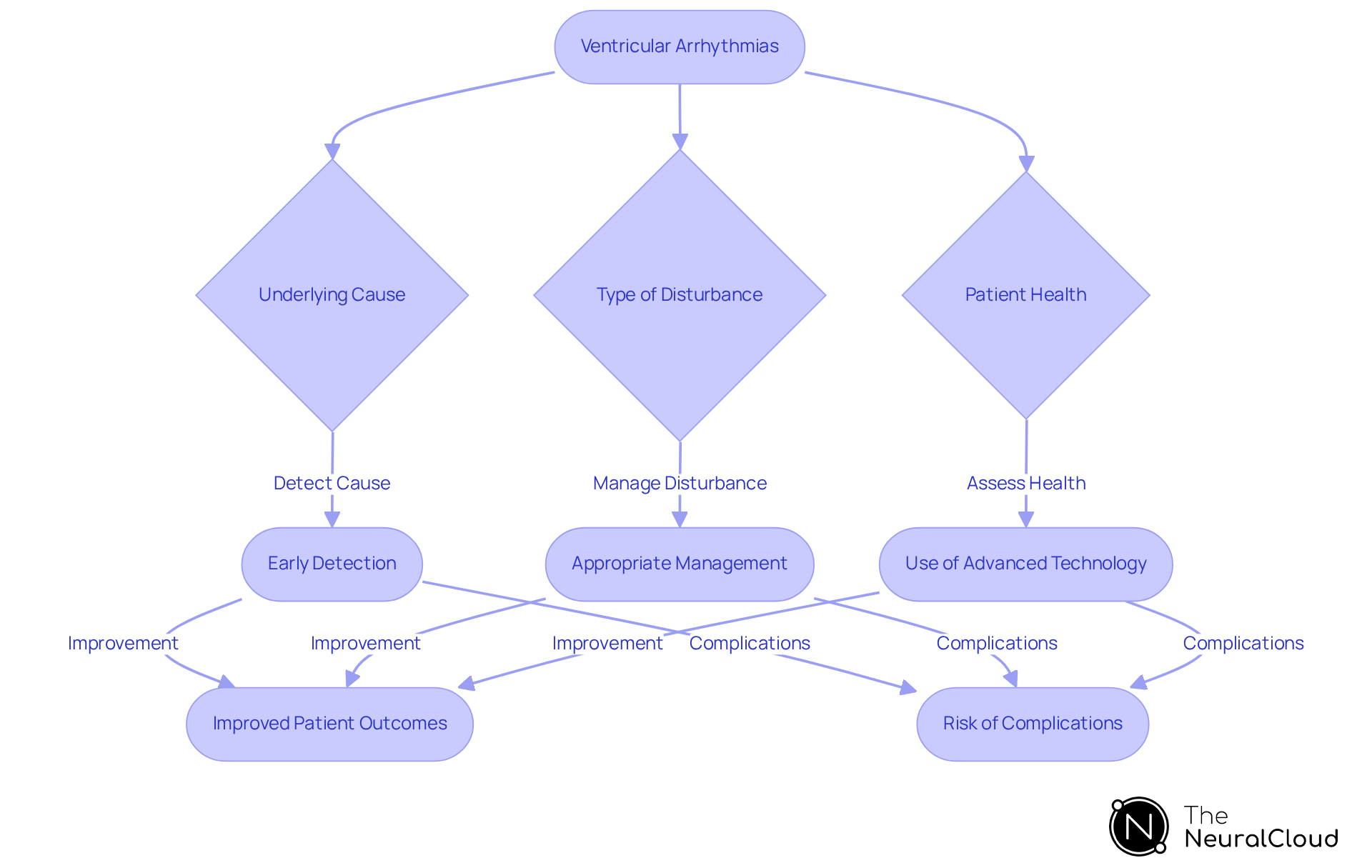
Future Directions in Ventricular Rhythm Research: Innovations and Emerging Trends
Future research in personalized medicine is likely to emphasize ventricular rhythms, utilizing genetic and biomarker data to customize treatments. A significant innovation in this area is the MaxYield™ platform, which automates ECG analysis to provide beat-by-beat insights and isolate key features in every heartbeat. This technology not only but also reduces costs, making it a valuable tool for healthcare professionals.
The MaxYield™ platform features advanced algorithms that improve the accuracy of ECG analysis. By integrating Neural Cloud Solutions' continuous learning model, the platform adapts to physiological variability and noise in ECG signals. This AI-driven automation ensures that diagnostic accuracy and treatment efficacy are continually enhanced, addressing the challenges faced in traditional ECG analysis.
Healthcare professionals can benefit significantly from these advancements. The automation provided by MaxYield™ allows for more efficient patient management, freeing up valuable time for clinicians to focus on patient care. Furthermore, the insights gained through automated analysis enable more informed decision-making, ultimately leading to better patient outcomes.
As health tech developers, it is crucial to stay informed about these trends and technologies. By understanding the capabilities of platforms like MaxYield™, developers can ensure their solutions remain relevant and effective in the ever-evolving landscape of healthcare technology.
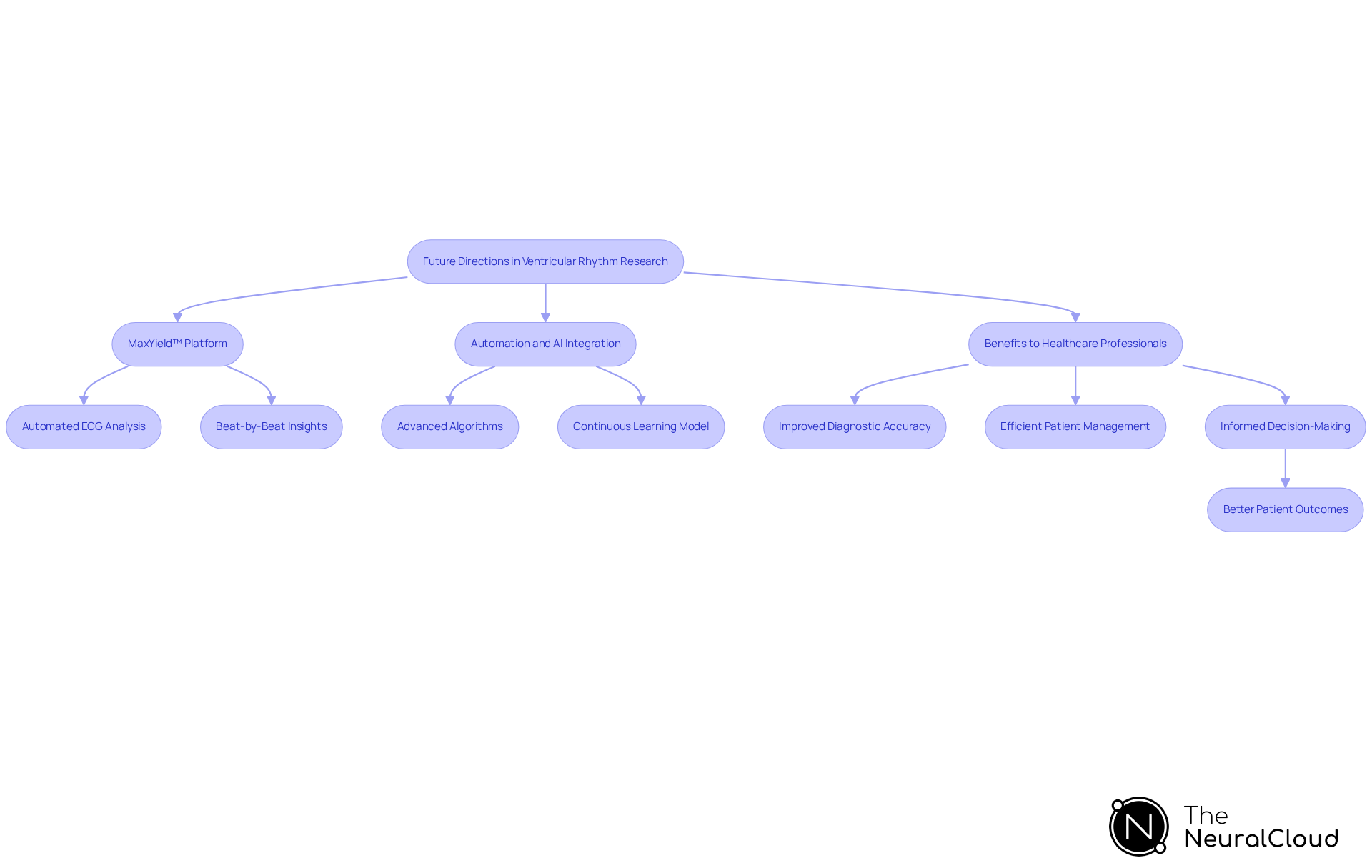
Conclusion
Understanding and addressing ventricular rhythms is essential for health tech developers aiming to improve diagnostic tools and patient care. The insights provided highlight the critical role of innovative technologies, such as Neural Cloud Solutions' MaxYield™ platform, in enhancing ECG analysis. By automating the detection and labeling of ventricular rhythms, this technology streamlines the diagnostic process and significantly improves the accuracy of identifying life-threatening conditions.
Key points discussed include:
- The various types of ventricular arrhythmias
- The physiological mechanisms behind them
- The importance of recognizing symptoms for timely intervention
The article emphasizes the significance of advanced diagnostic tools that integrate features like noise filtering and automated analysis to overcome challenges posed by physiological variability. These advancements are crucial for developing effective management strategies and improving patient outcomes.
As the landscape of healthcare technology continues to evolve, it is imperative for developers to stay informed about the latest trends and innovations in ventricular rhythm research. Leveraging platforms like MaxYield™ allows health tech creators to ensure their solutions remain relevant and impactful, ultimately leading to better clinical decision-making and enhanced patient care. Engaging with these advancements fosters innovation and reinforces the commitment to improving health outcomes in cardiovascular health.
Frequently Asked Questions
What is MaxYield™ by Neural Cloud Solutions?
MaxYield™ is an innovative platform that automates the detection and labeling of various ventricular rhythms in ECG analysis, utilizing advanced AI algorithms to process over 200,000 heartbeats in under five minutes.
How does MaxYield™ improve ECG analysis?
MaxYield™ enhances ECG analysis by providing rapid and accurate insights through advanced noise filtering and artifact handling, isolating and labeling key features in every heartbeat to improve reliability in diagnoses and treatment plans.
Why are ventricular rhythms important in cardiac function?
Ventricular rhythms are crucial as they originate from the heart's ventricles and abnormalities can lead to serious conditions like ventricular tachycardia or fibrillation, potentially resulting in sudden cardiac arrest.
What types of ventricular arrhythmias are identified by MaxYield™?
Key types of ventricular arrhythmias include Ventricular Tachycardia (VT), Ventricular Fibrillation (VF), and Premature Ventricular Contractions (PVCs).
How does MaxYield™ handle noisy ECG recordings?
MaxYield™ utilizes advanced noise reduction and artifact handling features to convert noisy ECG recordings into clear, actionable insights, improving the efficiency of analysis.
What are the key features of the MaxYield™ platform?
Key features include automated analysis of 200,000 heartbeats in under five minutes, detailed ECG characteristics analysis (P-wave, QRS complex, T-wave), and the ability to salvage obscured sections of lengthy ECG recordings.
How does MaxYield™ benefit healthcare professionals?
By improving the accuracy and efficiency of ECG interpretation over time, MaxYield™ aids in monitoring ventricular rhythms, ultimately enhancing patient care and clinical decision-making.

